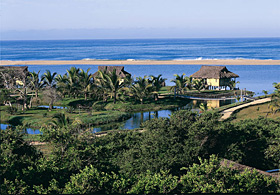 |
 |
 |
 Travel & Outdoors | December 2005 Travel & Outdoors | December 2005  
Eco-Hotel Hums In Harmony With Natural Surroundings
 Anita Draycott - Toronto Star Anita Draycott - Toronto Star


| | The Hotelito Desconocido is the brainchild of Marcello Murzilli, an Italian fashion designer who created Charro jeans in the 1970s. |
Near Cruz de Loreto — At the end of a narrow road between Puerto Vallarta and Manzanillo, there's a tiny hideaway called Hotelito Desconocido where travellers weary of traditional luxury resorts can keep it simple — and natural.

The Hotelito Desconocido, or "little unknown hotel" in Spanish, encourages visitors to Mexico's "Happy Coast" to shed the trappings of modern Western culture such as phones, computers, hairdryers and elevators. There's no need for them in a hotel that runs on solar power.

Hotelito's environmentally friendly mandate goes far beyond offering nature walks and asking that you think twice before requesting fresh towels.

It's the brainchild of Marcello Murzilli, an Italian fashion designer who created Charro jeans in the 1970s. On a sailing trip around the world he discovered these 40 hectares of hidden paradise and decided to "change the rules about hotels, reinterpret standards of luxury."

For four years he slept in a tent on the beach and worked with the townspeople of Cruz de Loreto, a remote fishing village four kilometres away, to create a hotel incorporating traditional Mexican arts and handicrafts.

Hotelito is located in the middle of a nature reserve. The estuary is an important bird sanctuary and the beach is a hatching ground for sea turtles. Both Murzilli and the Mexican government are committed to protecting this fragile environment.

"Windmills pump our water to us and the sun heats it. Mama cooks with gas. We have everything we need," Murzilli says.

There's a congenial relationship between the locals and Murzilli and nature. Checking in at Hotelito sets the tone. In the open-air "lobby" under a huge thatched hut, or palapa, stands an imposing wooden antique desk under a magnificent Mexican chandelier. To register, we simply sign our names in a massive parchment ledger.

Our bellboy pedals our luggage to our palafito — a hut built on stilts over the waters of the estuary that ring the resort. There is no key; you can stow your valuables in the reception's safety deposit box. Inside, our palafito is rustic simplicity with designer touches. The floors are pegged wood; the walls whitewashed adobe with splashes of vivid Mexican motifs. Balcony doors and window screens are woven mats. The four-poster bed is made up with exquisitely hand-embroidered linens and draped with a white mosquito net. For breakfast, tug a rope on the balcony and a red flag is hoisted to top of the roof. Minutes later, room service arrives bearing Mexican coffee with sugar and cinnamon and cookies.

The bathroom features a huge shower with a cobblestone and concrete floor, its wall of bamboo poles close enough together for privacy, but far enough apart to give it an open-air feeling.

Hotelito supplies Tepezcohuite soap made from an indigenous tree bark that protects from sun damage, chamomile shampoo and body cream.

A sophisticated sewage treatment system means you have the convenience of a flush toilet but paper goes in a basket.

We've arrived mid-afternoon and reception tells us lunch is being served on the beach. We follow the artfully raked path to a small dock where a muscular young man is waiting to row guests in a tiny skiff across the estuary to Hotelito's private beach. No powerboats are allowed; just row boats, canoes, windsurfers and sailboats.

At the tiny beach restaurant, we're served a refreshing drink of mineral water with freshly squeezed limes. We help ourselves to a fresh salad bar set in an ancient dugout canoe, then move on to ceviche and grilled T-bone steak.

Most of the fruit and vegetables served are grown organically in the Hotelito's own gardens. The fish are caught daily by the local fishermen.

By late afternoon, after a swim and siesta, my mellow spouse and I row ourselves back to El Cantarito, the mainland restaurant, for a couple of Pacifico beers and a game of pool. As the sun sets, the staff will light about 1,000 candles in the rooms and along the paths leading the way to El Cantarito, a larger version of our palafito.

We gather around the bar for cocktails and quesadillas. There are only 24 palafitos at Hotelito and the atmosphere is friendly and casual. After a few margaritas we have met most of our fellow guests, including a couple from Mexico City celebrating their first anniversary, a creative director and his wife from Toronto, and two handsome couples from New York who keep postponing their departure.

I get the impression that most of these people are seasoned travellers who have seen their fair share of traditional luxury hotels with miles of marble and silk, push-button gadgets and sophisticated heating and air conditioning systems.

But the Hotelito experience redefines one's standard of luxury. There's a harmony with nature that it makes you feel healthy, happy and a bit smug that you have discovered how good the simple things in life truly can be.

Anita Draycott is a Toronto-based freelance writer/photographer. | 
 | |
 |



